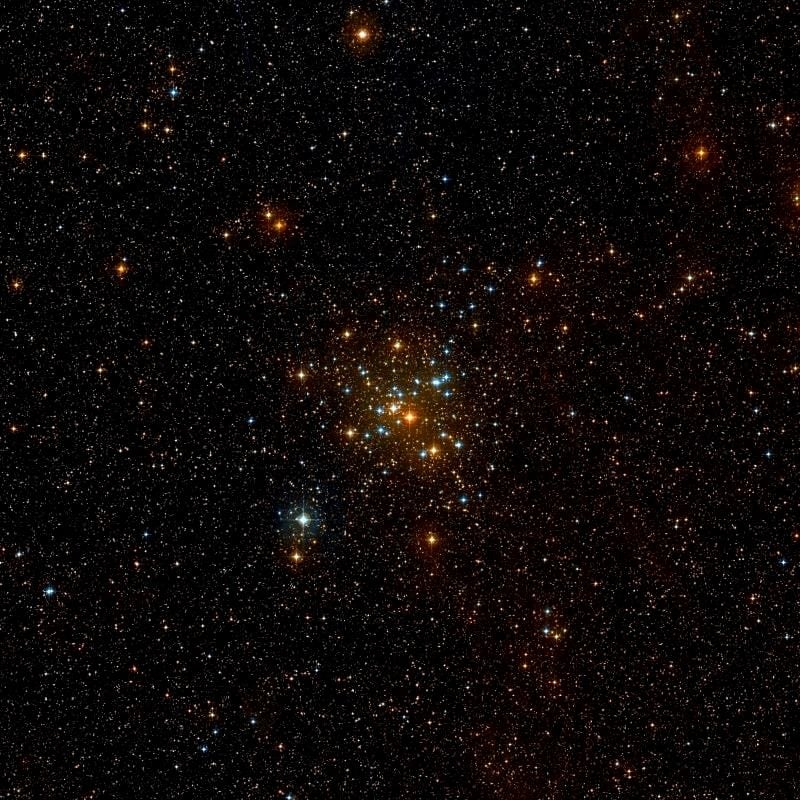Welcome back to Messier Monday! In our ongoing tribute to the great Tammy Plotner, we take a look at the double star known as Messier 41. Enjoy!
During the 18th century, famed French astronomer
Charles Messier
noted the presence of several "nebulous objects" in the night sky. Having originally mistaken them for comets, he began compiling a list of them so that others would not make the same mistake he did. In time, this list (known as the
Messier Catalog
) would come to include 100 of the most fabulous objects in the night sky.
One of these objects is the open star cluster known as Messier 41 (aka. M41, NGC 2287). Located in the
Canis Major
constellation - approximately 4,300 light years from Earth - this cluster lies just four degrees south of
Sirius
, the brightest star in the night sky. Like most open clusters, it is relatively young - 190 million years old - and contains over 100 stars in a region measuring 25 to 26 light years in diameter.
Description:
Running away from us at a speed of about 34 kilometers per second, this field of about 100 stars measures about 25 light years across. Born about 240 million years ago, it resides in space approximately 2300 light years away from our solar system. Larger aperture telescopes will reveal the presence of many red (or orange) giant stars and the hottest star in this group is a spectral type A.
[caption id="attachment_132549" align="aligncenter" width="571"]
View of the night sky in North Carolina, showing the constellations of Orion, Hyades, Canis Major and Canis Minor. Credit: NASA
[/caption]
As G.L.H. Harris (et al) explained in a
1993 study
:
But there's more than just red giant stars and various spectral types to be found hiding in Messier 41. There's at least two white dwarf stars, too. As P.D Dobbie explained in a
2009 study
:
[caption id="attachment_135450" align="aligncenter" width="580"]
Messier 41 and Collinder 121. Image: Wikisky
[/caption]
As you view Messier 41, you'll be impressed with its wide open appearance... and knowing it's simply what happens to star clusters as they get passed around our galaxy. As Giles Bergond (et al.) stated in their
2001
study:
That means we've only got another 360 million years to observe it before it's completely gone (though some estimates place it at about 500 million). Either way, this star cluster is destined to disappear, perhaps before we are!
History of Observation:
Messier 41 was "possibly" recorded by Aristotle about 325 B.C. as a patch in the Milky Way... quite understandable since it is very much within unaided eye visibility from a dark sky location. Said Aristotle:
[caption id="attachment_135451" align="aligncenter" width="580"]
Messier 41 and Sirius. Image: Wikisky
[/caption]
However, Giovanni Batista Hodierna was the first to catalog it in 1654, and the star cluster became a bit more astronomically known when John Flamsteed independently found it again on February 16, 1702. Doing his duty, Charles Messier also logged it:
Following suit, other historical astronomers also observed M41 - including Sir John Herschel to include it in the NGC catalog. While none found it particularly thrilling... their notes range from a "coarse collection of stars" to "very large, bright, little compressed", perhaps you will feel much differently about this easy, bright target!
Locating Messier 41:
Finding Messier 41 isn't very difficult for binoculars and small telescopes - all you have to know is the brightest star in the northern hemisphere, Sirius, and south! Simply aim your optics at Sirius and move due south approximately four degrees. That's about one standard field of view for binoculars, about one field of view for the average telescope finderscope and about 6 fields of view for the average wide field, low power eyepiece.
[caption id="attachment_135449" align="aligncenter" width="580"]
The location of Messier 41 in the Canis Major constellation. Credit: IAU and Sky & Telescope magazine/Roger Sinnott & Rick Fienberg
[/caption]
Because Messier 41 is a large star cluster, remember to use lowest magnification to get the best effect. Higher magnification can always be used once the star cluster is identified to study individual members. M41 is quite bright and easily resolved and makes a wonderful target for urban skies and moonlit nights!
Because
you
understand what's there...
- Object Name
-
Messier 41
- Alternative Designations
-
M41, NGC 2287
- Object Type
-
Open Galactic Star Cluster
- Constellation
-
Canis Major
- Right Ascension
-
06 : 46.0 (h:m)
- Declination
-
-20 : 44 (deg:m)
- Distance
-
2.3 (kly)
- Visual Brightness
-
4.5 (mag)
- Apparent Dimension
-
38.0 (arc min)
We have written many interesting articles about Messier Objects here at Universe Today. Here's Tammy Plotner's
Introduction to the Messier Objects
, ,
M1 – The Crab Nebula
,
M8 – The Lagoon Nebula
, and David Dickison's articles on the
2013
and
2014
Messier Marathons.
Be to sure to check out our complete
Messier Catalog
. And for more information, check out the
SEDS Messier Database
.
Sources:
 Universe Today
Universe Today
